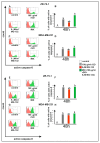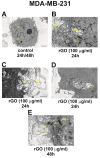The Synergistic Effect of Reduced Graphene Oxide and Proteasome Inhibitor in the Induction of Apoptosis through Oxidative Stress in Breast Cancer Cell Lines
- PMID: 38791473
- PMCID: PMC11121306
- DOI: 10.3390/ijms25105436
The Synergistic Effect of Reduced Graphene Oxide and Proteasome Inhibitor in the Induction of Apoptosis through Oxidative Stress in Breast Cancer Cell Lines
Abstract
Reduced graphene oxide (rGO) and a proteasome inhibitor (MG-132) are some of the most commonly used compounds in various biomedical applications. However, the mechanisms of rGO- and MG-132-induced cytotoxicity remain unclear. The aim of this study was to investigate the anticancer effect of rGO and MG-132 against ZR-75-1 and MDA-MB-231 breast cancer cell lines. The results demonstrated that rGO, MG-132 or a mix (rGO + MG-132) induced time- and dose-dependent cytotoxicity in ZR-75-1 and MDA-MB-231 cells. Apart from that, we found that treatment with rGO and MG-132 or the mix increased apoptosis, necrosis and induction of caspase-8 and caspase-9 activity in both breast cancer cell lines. Apoptosis and caspase activation were accompanied by changes in the ultrastructure of mitochondria in ZR-75-1 and MDA-MB-231 cells incubated with rGO. Additionally, in the analyzed cells, we observed the induction of oxidative stress, accompanied by increased apoptosis and cell necrosis. In conclusion, oxidative stress induces apoptosis in the tested cells. At the same time, both mitochondrial and receptor apoptosis pathways are activated. These studies provided new information on the molecular mechanisms of apoptosis in the ZR-75-1 and MDA-MB-231 breast cancer cell lines.
Keywords: apoptosis; breast cancer; cytotoxicity; oxidative stress; proteasome inhibitor (MG-132); reduced graphene oxide (rGO).
Conflict of interest statement
The authors declare no conflicts of interest.
Figures








References
-
- Han Y.H., Moon H.J., You B.R., Yang Y.M., Kim S.Z., Kim S.H., Park W.H. MG132, a proteasome inhibitor, induced death of calf pulmonary artery endothelial cells via caspase-dependent apoptosis and GSH depletion. Anticancer Res. 2010;30:879–885. - PubMed
MeSH terms
Substances
LinkOut - more resources
Full Text Sources
Medical
Miscellaneous

